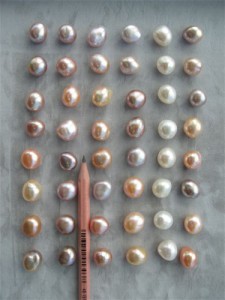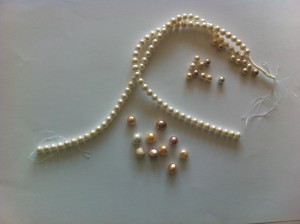 Generally speaking, freshwater pearls are not as round as saltwater pearls, and they do not have the same sharp luster and shine as Akoya pearls. However, they appear in a wide variety of shapes and natural colors, such as white, pink, orange, purple, and silver (for example). They also tend to be less expensive than saltwater pearls, making them very popular among younger people and designers. In addition, because freshwater pearls are normally solid nacre, they are also quite durable, resisting chipping, wear, and degeneration. They are produced abundantly in lakes and rivers by various freshwater mussels.
Generally speaking, freshwater pearls are not as round as saltwater pearls, and they do not have the same sharp luster and shine as Akoya pearls. However, they appear in a wide variety of shapes and natural colors, such as white, pink, orange, purple, and silver (for example). They also tend to be less expensive than saltwater pearls, making them very popular among younger people and designers. In addition, because freshwater pearls are normally solid nacre, they are also quite durable, resisting chipping, wear, and degeneration. They are produced abundantly in lakes and rivers by various freshwater mussels.
As far as our company is concerned now, we trade only the top grades of those pearls and almost exclusively the Japanese “Biwa” freshwater pearls. The Japanese have a distinguished history of cultivating freshwater pearls. Lake Biwa was once world renowned for producing high-quality freshwater pearls produced by the Hyriopsis schlegelii or “Biwa mussel”. However, in the mid 1970′s pearl farming came to a halt due to pollution in the lake that was once synonymous with freshwater pearls. Subsequently, the Japanese knowhow “migrated” to the lakes of China where our fellow cultivators now produce our nominated qualities themselves.
At this point, we would like to highlight that our freshwater pearls are of exceptional quality and rival gemstones. We offer only premium “Biwa” pearls cultivated in lakes – not rivers – in China based on the Japanese precedent and just the crème-de-la-crème of the production of our fellow farmers, which isn’t more than the 2% of their harvest, comes in our stock. In contrast to the saltwater pearls, the freshwater production that reaches the market from the farms, is much larger (approx. 60%) than the seawater pearls (approx. 10%). Therefore very careful selection is the absolute key to avoid tricky overrated qualities that sometimes are seen even in supermarkets… We do the selection for you, free of charge, so don’t worry!

